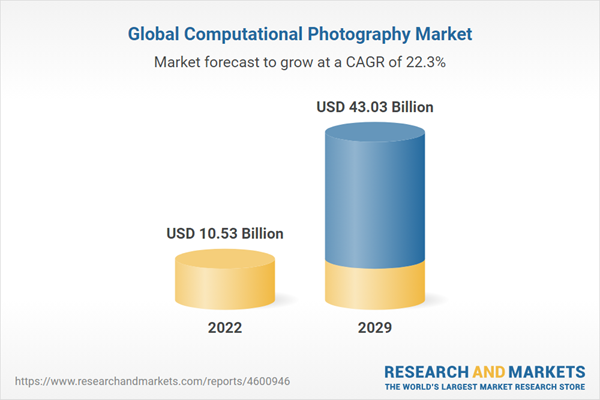Camera settings can be automated through computational photography allowing for better point-and-shoot photography on digital cameras and particularly smartphones. The hardware is used for advanced computation to facilitate computational photography. By compressing, expanding, and mosaicking an image, this software system enhances and expands the capabilities of computational photography.
The computation photography market is also being driven by the increasing adoption of image fusion techniques to achieve high-quality images. Recently, fusion techniques have gained popularity in various types of applications, making the need for objective, systematic, and quantitative methods to assess or evaluate the performance of these technologies urgently necessary.
Market Drivers
Increasing use of Smartphones:
In the last ten years, there has been a remarkable enhancement in the picture-taking capabilities of smartphones, with cameras experiencing exponential growth in recent years. Presently, mobile phone manufacturers are actively revealing plans to incorporate Artificial Intelligence (AI) and machine learning into their devices. Leveraging the Qualcomm Spectra ISP technology alongside computational photography capabilities holds the potential to elevate smartphone photography to unprecedented heights.As consumers increasingly turn to smartphones for capturing memories and sharing content, there is a growing demand for superior image quality. Techniques such as HDR imaging, multi-frame noise reduction, and AI-driven scene optimization contribute to delivering professional-looking results directly from smartphones.
Growing Use of AI-technology:
Artificial Intelligence (AI) is spearheading a revolution in computational photography, with advanced AI algorithms analyzing and optimizing images in real time. This technology enables automatic adjustments to settings, noise removal, detail enhancement, and the creation of bokeh effects, thereby enhancing image quality under diverse lighting conditions.With features like AI-powered portrait mode and super-resolution, smartphone photography is taken to new heights as AI intelligently manipulates depth and detail, providing users with more sophisticated and appealing results.
Restraint:
High cost:
The market growth of computational camera modules is however held back by high maintenance and manufacturing costs. The price of mobile phones rises as smartphone vendors strive to improve image quality.Global Computational photography market segmentation by application into cameras, smartphones and machine vision:
The Computational Photography Market is segmented based on applications into Cameras, Smartphones, and Machine Vision. For Cameras, the applications span professional photography, sports photography, wildlife photography, astrophotography, and cinematography.In the realm of Smartphones, computational photography finds use in everyday photography, social media sharing, vlogging, and content creation. Machine Vision applications encompass industrial inspection, manufacturing process control, autonomous vehicles, security and surveillance, and medical imaging.
APAC is anticipated to hold a significant share of the global computational photography market:
The Asia-Pacific (APAC) region has experienced one of the swiftest rates of smartphone adoption on a global scale, notably in countries such as India, China, and Indonesia. The expansive and continually expanding user base for smartphones in this region generates a significant demand for cutting-edge camera features facilitated by computational photography.In APAC, local companies are proactively investing in the development and integration of computational photography technologies into their products. Leading smartphone manufacturers like Huawei, Oppo, and Xiaomi are at the forefront, placing substantial emphasis on innovation and setting themselves apart through advanced camera technologies.
Market Developments:
- November 2023- OPPO and Hasselblad announced their collaboration to co-develop the next generation of HyperTone Camera Systems, focusing on aesthetics. The systems were initially set to arrive in future Find series flagships, offering users an unprecedented mobile imaging experience beyond imagination. Two companies launched the next-generation HyperTone Camera Systems and Hasselblad camera experience, promising to continue setting new industry standards.
- June 2023- Sony Semiconductor Solutions Corporation (SSS) announced that it shipped a new line of LYTIA brand products, primarily 50-megapixel models, in the fiscal year. LYTIA represents the new product brand of image sensors for mobile devices developed by SSS. The company leveraged its imaging and sensing technologies to bring value to the market in various ways and delivered a richer imaging experience to users.
- May 2022- Xiaomi officially announced a strategic partnership in imagery technology with Leica Camera. The partnership represented a comprehensive integration of Xiaomi and Leica Camera's imaging capabilities, encompassing optics, imaging, image processing, photography experience, and various other factors related to smartphone imagery.
Market Segmentation
By Application
- Cameras
- Smart Phones
- Machine Vision
By Geography
- North America
- USA
- Canada
- Mexico
- South America
- Brazil
- Argentina
- Others
- Europe
- UK
- Germany
- France
- Italy
- Others
- Middle East and Africa
- Saudi Arabia
- UAE
- Others
- Asia Pacific
- Japan
- China
- India
- Indonesia
- Taiwan
- Thailand
- Others
Table of Contents
Companies Mentioned
- Light
- Alphabet
- Microsoft Corporation
- Samsung
- Facebook Inc.
- Apple Inc.
- Corephotonics Ltd.
- Micron Technology
- Guandong Oppo Mobile Telecommunications Corp.
- Photogram AI
Table Information
| Report Attribute | Details |
|---|---|
| No. of Pages | 129 |
| Published | March 2024 |
| Forecast Period | 2022 - 2029 |
| Estimated Market Value ( USD | $ 10.53 Billion |
| Forecasted Market Value ( USD | $ 43.03 Billion |
| Compound Annual Growth Rate | 22.2% |
| Regions Covered | Global |
| No. of Companies Mentioned | 10 |









